Wallenfeldt J. The American Revolutionary War and the War of 1812: People, Politics, and Power
Подождите немного. Документ загружается.


his Revolutionary War service he was
wounded at the Battle of Bunker Hill
(June 17, 1775). He helped repel the Con-
tinental Army’s invasion of Canada (1776)
and was noted for distinguished service in
the early part of Gen. John Burgoyne’s
invasion of the Hudson River valley.
After fighting in North Carolina (1781),
Craig was promoted to lieutenant colonel.
He played a leading role in the capture
(1795) of the Dutch colony of the Cape of
Good Hope and served as its temporary
governor (1795–97). Knighted in 1797, he
was given commands in India and in
England and saw service in the renewed
Napoleonic Wars.
In 1807 Craig was appointed gover-
nor-general of Canada, a post to which he
was temperamentally unsuited. His
cooperation with the governing clique in
Quebec and his repressive policy toward
the French-Canadians were not popular.
He resigned his post in 1811 and returned
to England, where he was promoted to
general just before his death.
Patrick Ferguson
(b. 1744, Pitfours, Aberdeenshire,
Scot.—d. Oct. 7, 1780, Kings
Mountain, S.C.)
Scottish soldier and marksman Patrick
Ferguson, who served in the British army
during the American Revolution, was the
inventor of the Ferguson flintlock rifle.
Ferguson served in the British army
from 1759. In 1776 he patented a rifle—one
of the earliest practical breechloaders—
that was the best military firearm used in
temporary defeat (1792) on Tippu Sultan,
the anti-British ruler of the Mysore state.
For his services in India he was created a
marquess in 1792.
As viceroy of Ireland (1798–1801),
Cornwallis won the confidence of both
militant Protestants (Orangemen) and
Roman Catholics. After suppressing a
serious Irish rebellion in 1798 and defeat-
ing a French invasion force on September
9 of that year, he wisely insisted that only
the revolutionary leaders be punished. As
he had done in India, he worked to elimi-
nate corruption among British ocials in
Ireland. He also supported the parliamen-
tary union of Great Britain and Ireland
(eective Jan. 1, 1801) and the concession
of political rights to Roman Catholics
(rejected by King George III in 1801, caus-
ing Cornwallis to resign).
As British plenipotentiary, Cornwallis
negotiated the Treaty of Amiens (March 27,
1802), which established peace in Europe
during the Napoleonic Wars. He was reap-
pointed governor-general of India in 1805
but died shortly after his arrival.
Sir James Craig
(b. 1748, Gibraltar—d. Jan. 12, 1812,
London, Eng.)
Sir James Craig was a British veteran of
the American Revolution, but he became
better known later as governor-general
of Canada (1807–11) and was charged by
French-Canadians with conducting a
“reign of terror” in Quebec.
Craig entered the British army at the
age of 15 and was made captain in 1771. In
Military Figures of the American Revolution | 125
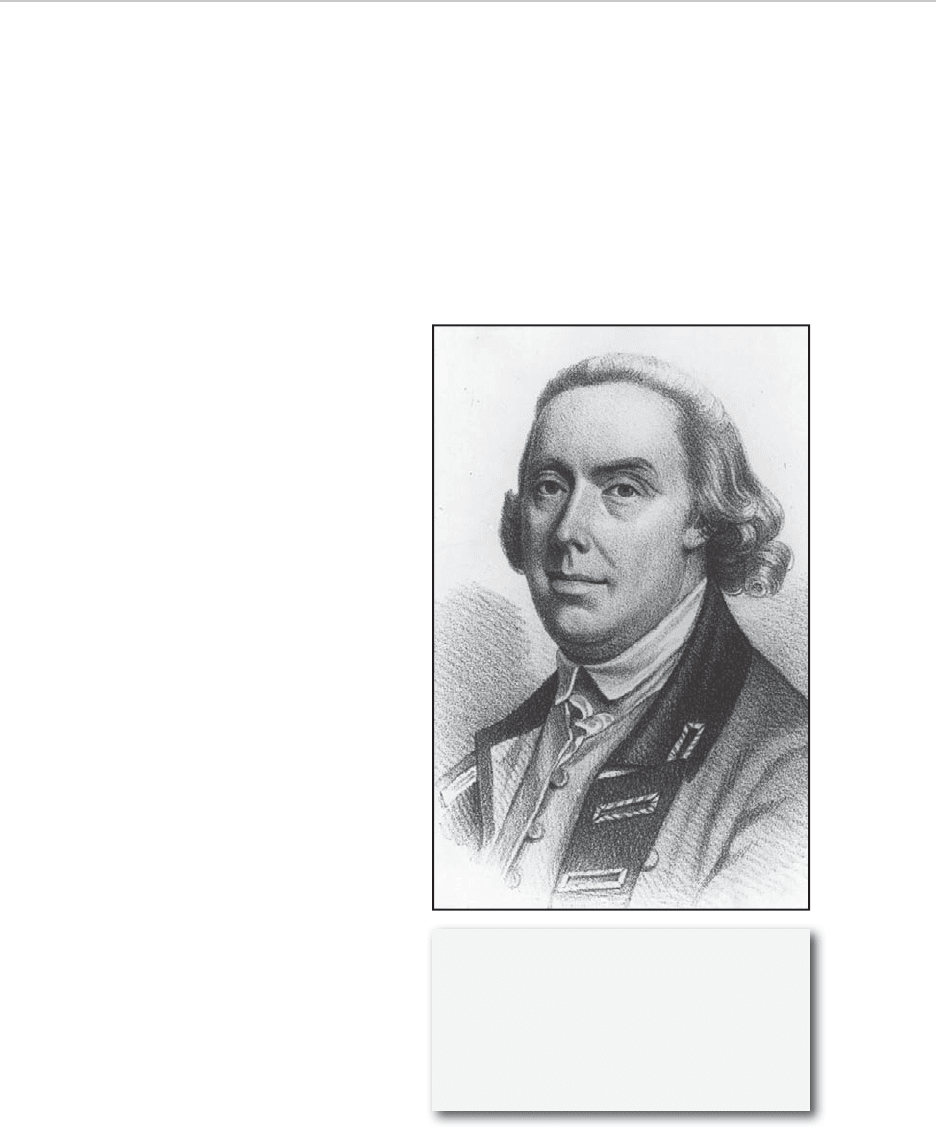
126 | The American Revolutionary War and the War of 1812: People, Politics, and Power
operation against Quebec (1759–60). He
was thereupon made governor of
Montreal (1760) and promoted to major
general (1761).
In 1763 Gage was appointed com-
mander in chief of all British forces in
North America—the most important
and infl uential post in the colonies.
Headquartered in New York, he ran a
vast military machine of more than 50
the American Revolution. His breechlock
was grooved to prevent the action’s being
jammed with powder. The rifl e could be
fi red six times a minute, a major advance
in fi repower for the time, but because of
o cial British conservatism not more
than 200 of them were used in the war.
Ferguson led a small force armed
with his rifl e during the Pennsylvania
campaign of 1777. At the Battle of
Brandywine, his right arm was perma-
nently crippled. Considered one of the
British army’s best leaders of light troops,
he recruited a corps of New York loyalists
in 1779 for service in the American South,
using it as a cadre for locally enlisted
loyalist militia. All of these men carried
muskets at the Battle of Kings Mountain
in 1780, when Ferguson was killed and his
unit annihilated.
Thomas Gage
(b. 1721, Firle, Sussex, Eng.—d. April 2,
1787, Eng.)
British Gen. Thomas Gage successfully
commanded all British forces in North
America for more than 10 years (1763–74)
but failed to stem the tide of rebellion as
military governor of Massachusetts
(1774–75) at the outbreak of the American
Revolution.
Gage’s military career in North
America began in 1754, when he sailed
with his regiment to serve in the last
French and Indian War (1756–63). He
participated in Gen. Edward Braddock’s
disastrous campaign in western Penn-
sylvania (1754) and in the successful
Gen. Thomas Gage, known as “The
Lenient Commander,” was commander
in chief of the British forces in Amer-
ica until he was replaced by Gen.
William Howe in 1775. Hulton Archive/
Getty Images

disastrous Battle of Bunker Hill in June,
Gage was succeeded by Gen. Sir William
Howe. He soon returned to England and
was commissioned a full general in 1782.
Charles Grey, 1st Earl Grey
(b. 1729, Howick, Northumberland,
Eng.—d. Nov. 14, 1807, Howick)
Lord Charles Grey served as a British
general during the American Revolution
and as a commander was credited with
victories in several battles, notably
against Gen. Anthony Wayne and at the
Battle of Germantown (1777–78).
A member of an old Northumberland
family and son of Sir Henry Grey, Baronet,
Grey entered the army at age 19 and, by
1755, had become lieutenant colonel,
serving with forces in France and
Germany in the years 1757–61 and in the
capture of Havana (1762). Out of service
and on half-pay after the peace of 1763,
he returned to service as a colonel in
1772. In 1776 he went to America with
Gen. Sir William Howe, receiving the
rank of major general. His successes as a
commander were remarkable in the
northern theatre from Pennsylvania to
eastern Massachusetts. His night attack
with the bayonet on the American camp
at Paoli in 1777, widely denounced as an
atrocity, earned him the cognomen
“No-Flint Grey.” After returning home in
1778, he was promoted to lieutenant gen-
eral in 1782 and appointed commander in
chief in America, though, the war soon
ending, he never took command. After
the French Revolution he saw service in
garrisons and stations stretching from
Newfoundland to Florida and from Ber-
muda to the Mississippi. He exhibited
both patience and tact in handling mat-
ters of diplomacy, trade, communication,
Indian relations, and western boundar-
ies. His great failure, however, was in
his assessment of the burgeoning inde-
pendence movement. As the main
permanent adviser to the mother coun-
try in that period, he sent critical and
unsympathetic reports that did much to
harden the attitude of successive minis-
tries toward the colonies.
When resistance turned violent at
the Boston Tea Party (1773), Gage was
instrumental in shaping Parliament’s
retaliatory Intolerable (Coercive) Acts
(1774), by which the port of Boston was
closed until the destroyed tea should
be paid for. He was largely responsible
for inclusion of the inflammatory provi-
sion for quartering of soldiers in private
homes and of the Massachusetts Gov-
ernment Act, by which colonial
democratic institutions were superseded
by a British military government. Thus
Gage is chiefly remembered in the U.S.
as the protagonist of the British cause
while he served as military governor in
Massachusetts from 1774 to 1775. In this
capacity, he ordered the march of the red-
coats on Lexington and Concord (April
1775), which was intended to uncover
ammunition caches and to capture the
leading Revolutionary agitator, Samuel
Adams, who escaped. This unfortunate
manoeuvre signalled the start of the
American Revolution; after the equally
Military Figures of the American Revolution | 127

128 | The American Revolutionary War and the War of 1812: People, Politics, and Power
the south bank of the Delaware River and
won two successive victories over the
Americans at the Battle of Brandywine
(September) and the Battle of German-
town (October). His next winter was
spent in the occupation of Philadelphia.
Howe recognized his failure, however, to
destroy the modest force of Gen. George
Washington, then encamped at nearby
Valley Forge. His Pennsylvania campaign
had furthermore exposed the troops of
Gen. John Burgoyne in upper New York
State and led to the disastrous British
defeat at the Battle of Saratoga that fall.
Under increasing criticism from the
British press and government, Howe
resigned his command before the start of
operations in 1778.
Returning to England, Howe saw no
more active service but held a number
of important home commands. He suc-
ceeded to the viscountcy on the death of
his brother in 1799; upon his own death,
without issue, the peerage expired.
Wilhelm, Baron von
Knyphausen
(b. Nov. 4, 1716, Luxembourg—d. Dec. 7,
1800, Kassel, Hesse-Kassel [Ger.])
After 1777 German ocer Baron von
Knyphausen commanded “Hessian”
troops who fought on the British side in
the American Revolution.
A lieutenant general with 42 years of
military service, Knyphausen went to
North America in 1776 as second in com-
mand (under Gen. Leopold von Heister)
of German mercenary troops in the
the West Indies. He retired and was given
a barony in 1801; in 1806 he was raised to
Viscount Howick and Earl Grey.
William Howe,
5th Viscount Howe
(b. Aug. 10, 1729—d. July 12, 1814,
Plymouth, Devonshire, Eng.)
Despite several military successes, Gen.
Sir William Howe, the commander in
chief of the British army in North America
from 1776 to 1778, failed to destroy the
Continental Army and stem the American
Revolution.
Brother of Adm. Richard Lord Howe,
William Howe had been active in North
America during the last French and
Indian War, in which he earned a reputa-
tion as one of the army’s most brilliant
young generals. Sent in 1775 to reinforce
Gen. Thomas Gage in the Siege of Boston,
he led the left wing in three costly but
finally successful assaults in the Battle of
Bunker Hill.
Assuming supreme command the
following year, Howe transferred his
forces southward and captured the stra-
tegic port city of New York, severely
defeating the Americans at the Battle of
Long Island. A competent tactician, he
preferred maneuver to battle, partly to
conserve scarce British manpower, but
also in the hopes of demonstrating British
military superiority so convincingly that
the Americans would accept negotiation
and reconciliation with Britain.
When active operations were resumed
in June 1777, Howe moved his troops to

a separate peace with the Americans. For
these actions, Red Jacket was considered
a coward by many of his own people. But
he put his splendid oratorical skills to pro-
testing the inevitable peacemaking with
the United States at an Indian council in
1786, and his oratory succeeded in sus-
taining him as a Seneca chief.
Red Jacket constantly sought to por-
tray himself as a bitter enemy of the
whites. Yet, while he publicly opposed
land sales in 1787, 1788, and 1790, he
secretly signed the property cessions to
protect his prestige with the Americans.
Later, however, he seems to have become
more sincere in protesting white influ-
ence on Seneca customs, religion, and
language. He vehemently opposed mis-
sionaries’ living on Indian lands, and he
vainly attempted to preserve Indian
jurisdiction over criminal acts commit-
ted on Indian property.
During the 1820s Red Jacket lost
prestige as his drinking and general dis-
sipation became evident. In 1827 he was
deposed as chief by a council of tribal
leaders—only to be reinstated following a
personal eort at reform and the interces-
sion of the U.S. Oce of Indian Aairs.
British service. Following Heister’s recall
in 1777, Knyphausen became their com-
mander. He took part in the battles of
Fort Washington and Brandywine, Pa,
and Monmouth, N.J.; Sir Henry Clinton’s
absence from New York in 1779–80 left
the area under the command of
Knyphausen. An able soldier, he carried
out the dicult task of holding together
the mercenary forces under his com-
mand. He returned to Germany in 1782
and became military governor of Kassel.
Red Jacket
(b. 1758?, Canoga, N.Y.—d. Jan. 20,
1830, Seneca Village, Bualo, N.Y.)
Seneca Indian chief Sagoyewatha (birth
name, Otetiani) was known as “Red
Jacket” for the succession of red coats
he wore while fighting on the British
side during the American Revolution. He
used his gift for oratory to mask his
schemes to maintain his position of
power despite double-dealing against his
people’s interests.
Red Jacket retreated at the approach
of Gen. John Sullivan’s American troops
in 1779, and he even attempted to conclude
Military Figures of the American Revolution | 129
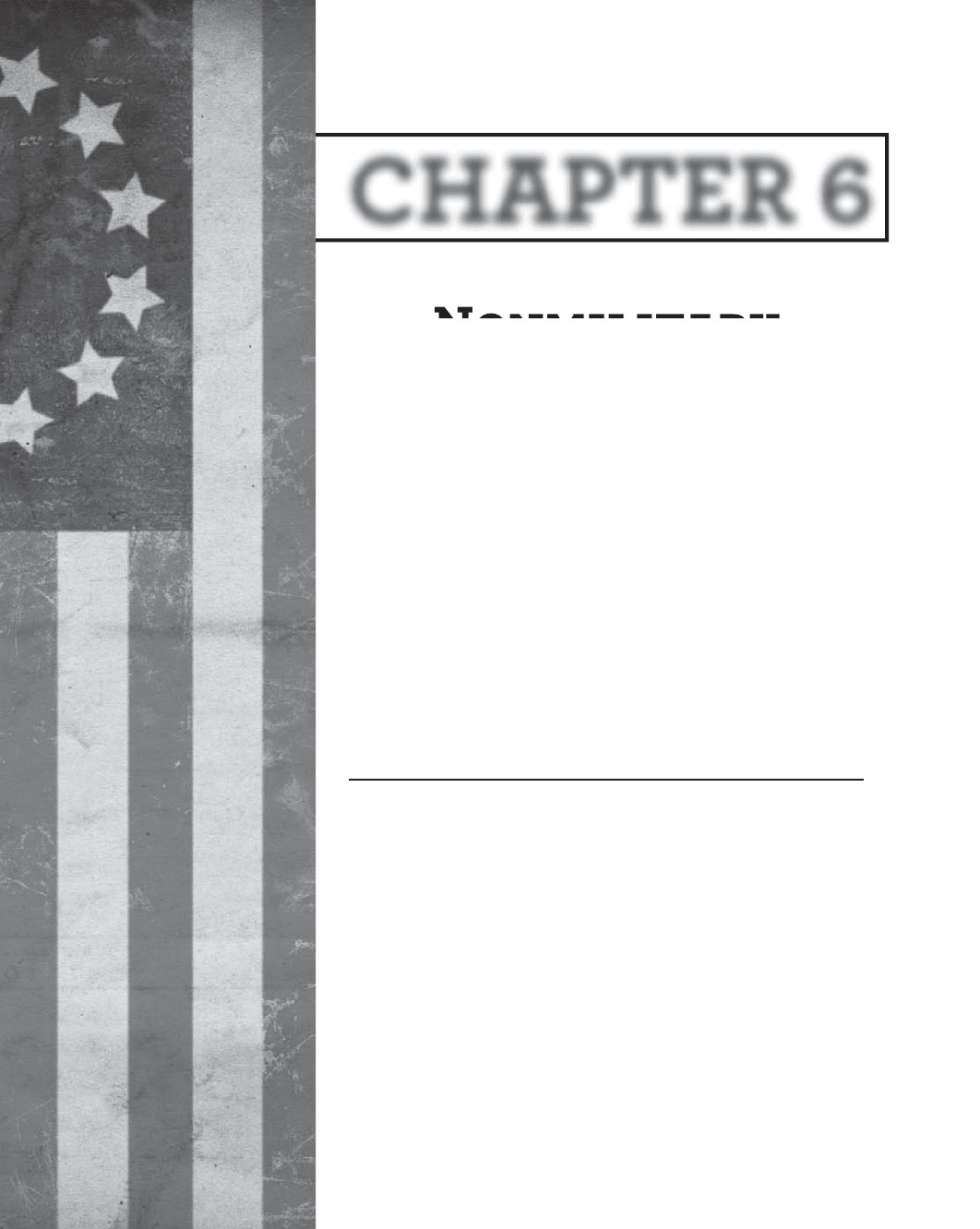
Nonmilitary
Figures of the
American
Revolution
M
any of those who made valuable contributions to the
American cause did so without ever taking up a
weapon in its defense. These leaders included politicians
who laid down the framework for the Revolution, writers
whose fi ery words inspired action, fi nanciers who funded the
fi ght, and diplomats who persuaded other countries to assist
the revolutionary cause. Their actions helped pave the way
to the American victory.
ThE AMERICAN SIDE
John Adams
(b. Oct. 30, 1735, Braintree, Mass.—d. July 4, 1826,
Quincy, Mass.)
Before becoming the fi rst vice president (1789–97) and second
president (1797–1801) of the United States, John Adams
played a pivotal role in the Continental Congress and served
as a diplomat during the Revolution. After graduating from
Harvard College in 1755, he practiced law in Boston. In 1764 he
married Abigail Smith. Active in the American independence
movement, he was elected to the Massachusetts legislature
and served as a delegate to the Continental Congress (1774–78),
Nonmilitary
ChAPTER 6
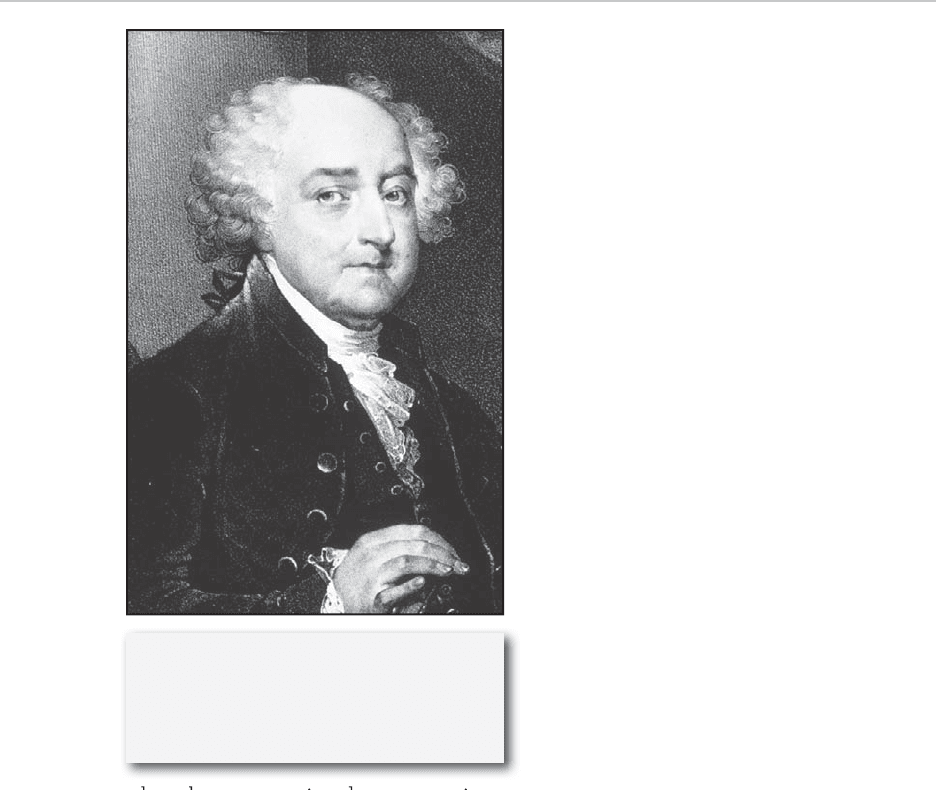
Nonmilitary Figures of the American Revolution | 131
was marked by controversy over his sign-
ing of the Alien and Sedition Acts in 1798
and by his alliance with the conservative
Federalist Party. In 1800 he was defeated
for reelection by Je erson and retired to
live a secluded life in Massachusetts. In
1812 he overcame his bitterness toward
Je erson, with whom he began an illumi-
nating correspondence. Both men died on
July 4, 1826, the Declaration’s 50th anni-
versary. John Quincy Adams was his son.
Samuel Adams
(b. Sept. 27, 1722, Boston, Mass.—
d. Oct. 2, 1803, Boston)
Bostonian Samuel Adams was among the
most prominent leaders of the Rev olution.
A cousin of John Adams, he graduated
from Harvard College in 1740 and briefl y
practiced law. He became a strong oppo-
nent of British taxation measures and
organized resistance to the Stamp Act.
He was a member of the state legislature
(1765–74), and in 1772 he helped found the
Committees of Cor respondence. He infl u-
enced reaction to the Tea Act of 1773,
organized the Boston Tea Party, and led
opposition to the Intol erable Acts. A dele-
gate to the Continental Congress (1774–81),
he continued to call for separation from
Britain and signed the Declaration of
Independence. He helped draft the
Massachusetts constitution in 1780 and
served as the state’s governor (1794–97).
Crispus Attucks
(b. 1723?—d. March 5, 1770,
Boston, Mass. )
where he was appointed to a committee
with Thomas Je erson and others to draft
the Declaration of Independence. In 1776–
78 he was appointed to many congressional
committees, including one to create a navy
and another to review foreign a airs. He
served as a diplomat in France, the Neth-
erlands, and England (1778–88). In the
fi rst U.S. presidential election, he received
the second largest number of votes and
became vice president under George
Washington. Adams’s term as president
where he was appointed to a committee
John Adams the second president of
the United States, helped draft the
Declaration of Independence. MPI/
Hulton Archive/Getty Images
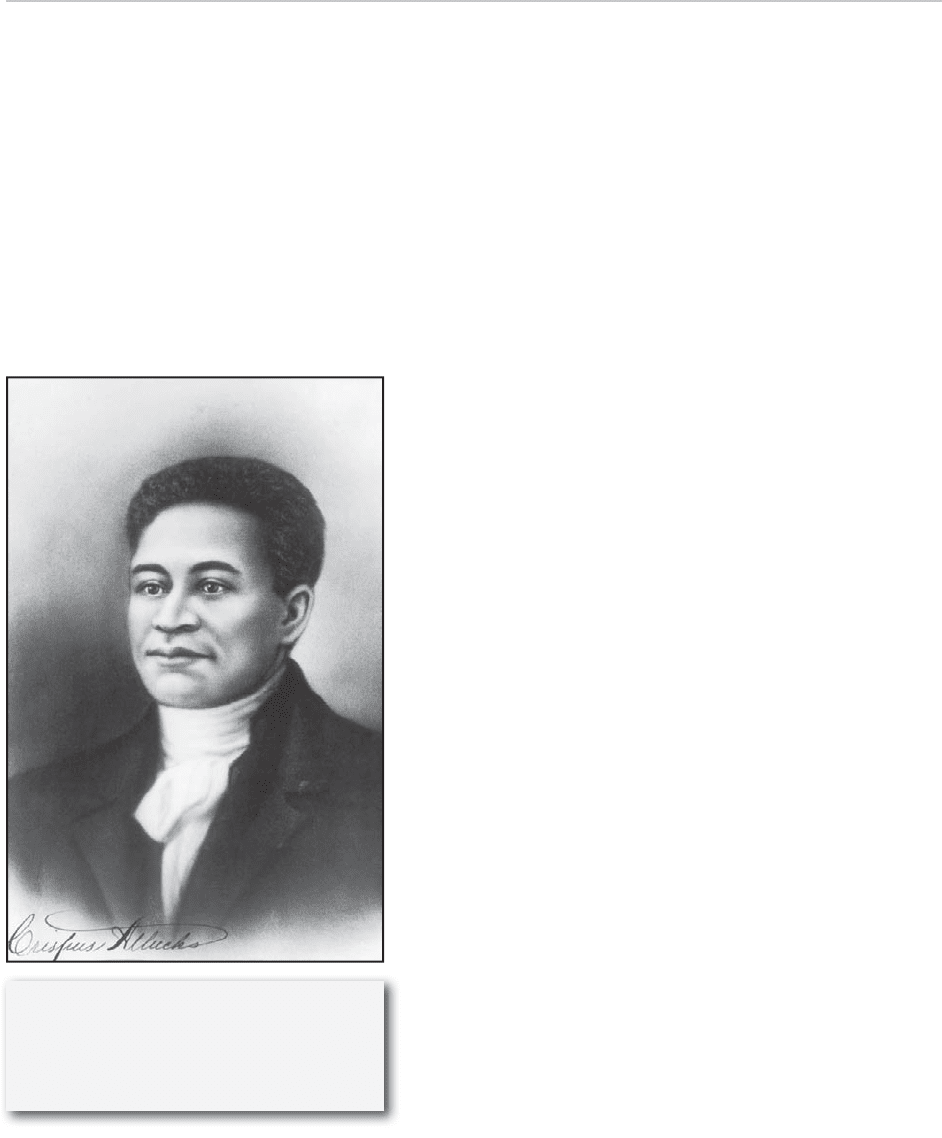
132 | The American Revolutionary War and the War of 1812: People, Politics, and Power
the 20-year interval between his escape
from slavery and his death at the hands of
British soldiers, Attucks probably spent a
good deal of time aboard whaling ships.
All that is defi nitely known about him
concerns the Boston Massacre on March 5,
1770. Toward evening that day, a crowd of
colonists gathered and began taunting a
small group of British soldiers. Tension
mounted rapidly, and when one of the
soldiers was struck the others fi red their
muskets, killing three of the Americans
instantly and mortally wounding two
others. Attucks was the fi rst to fall, thus
becoming one of the fi rst men to lose his
life in the cause of American independence.
His body was carried to Faneuil Hall,
where it lay in state until March 8, when
all fi ve victims were buried in a common
grave. Attucks was the only victim of the
Boston Massacre whose name was widely
remembered. In 1888 the Crispus Attucks
monument was unveiled in the Boston
Common.
Anna Warner Bailey
(b. Oct. 11?, 1758, Groton, Conn.—
d. Jan. 10, 1851, Groton)
American patriot Anna Warner Bailey’s
heroic actions during the Revolution are
the stu of legend.
Anna Warner was orphaned and was
reared by an uncle. On Sept. 6, 1781, a
large British force under the turncoat
Gen. Benedict Arnold landed on the coast
near Groton and stormed Fort Griswold.
American casualties were very high, and
among them was Warner’s uncle, Edward
Crispus Attucks is remembered as an
American hero and martyr of the Boston
Massacre .
Attucks’s life prior to the day of his
death is still shrouded in mystery. Most
historians say that he was black; others
argue that his ancestry was both African
and Natick Indian. In any event, in the
fall of 1750, a resident of Framingham,
Mass., advertised for the recovery of a
runaway slave named Crispus—usually
thought to be the Crispus in question. In
Crispus Attucks, a runaway slave, was
killed in 1770 by British troops during
the Boston Massacre. Archive Photos/
Getty Images

six years (1789–95) as a member of the
national House of Rep resentatives. He
became director of the U.S. Mint at
Philadelphia in 1795 and held that posi-
tion for 10 years.
James Bowdoin
(b. Aug. 7, 1726, Boston, Mass.—
d. Nov. 6, 1790, Boston)
In addition to being the founder and first
president of the American Academy of Arts
and Sciences (1780), James Bowdoin was
an important political leader in Massachu-
setts during the era of the Revolution.
Bowdoin graduated from Harvard in
1745. A merchant by profession, he was
president of the constitutional convention
of Massachusetts (1779–80) and a member
of the state convention to ratify the fed-
eral Constitution (1788). As governor of
Massachusetts (1785–87), he took prompt
action to suppress Shays’s Rebellion (an
uprising among poor and heavily taxed
farmers) and was, in general, a stabilizing
force in the critical postwar period.
Bowdoin was also a scientist promi-
nent in physics and astronomy. He wrote
several papers, including one on elec-
tricity with Benjamin Franklin. Bowdoin
College, Brunswick, Maine, was named
in his honour.
David Bushnell
(b. 1742, Saybrook, Conn.—d. 1824,
Warrenton, Ga.)
American inventor David Bushnell is
renowned as the father of the submarine,
Mills. She walked several miles to the
scene of battle, found her uncle after much
diculty, and learned that he was mortally
wounded. At his request she hurried home,
saddled a horse for her aunt, and carried
her infant cousin back for a last meeting
of the family. This feat soon became a
favourite tale of the Revolution. Warner
later married Capt. Elijah Bailey, post-
master of Groton. In 1813, during the
second war with Great Britain, “Mother
Bailey,” as she was then known, appeared
among the Groton soldiers aiding in the
defense of New London against a blockad-
ing British fleet. On learning of a shortage,
she contributed her flannel petticoat—her
“martial petticoat,” as it came to be known—
for use as cartridge wadding.
Elias Boudinot
(b. May 2, 1740, Philadelphia, Pa.—
d. Oct. 24, 1821, Burlington, N.J.)
Lawyer and public ocial Elias Boudinot
was a party to more than a few important
political developments in the Revolution
and early days of the republic.
Boudinot became a lawyer and attor-
ney-at-law in 1760. He was a leader in his
profession, and, though he was a conser-
vative Whig, he supported the American
Revolution. He became a member of the
Revolutionary Party at the outbreak of
the war, serving first as deputy in the New
Jersey provincial assembly and then as
one of New Jersey’s representatives in
the Continental Congress. After the estab-
lishment of the government of the United
States of America, Boudinot served for
Nonmilitary Figures of the American Revolution | 133
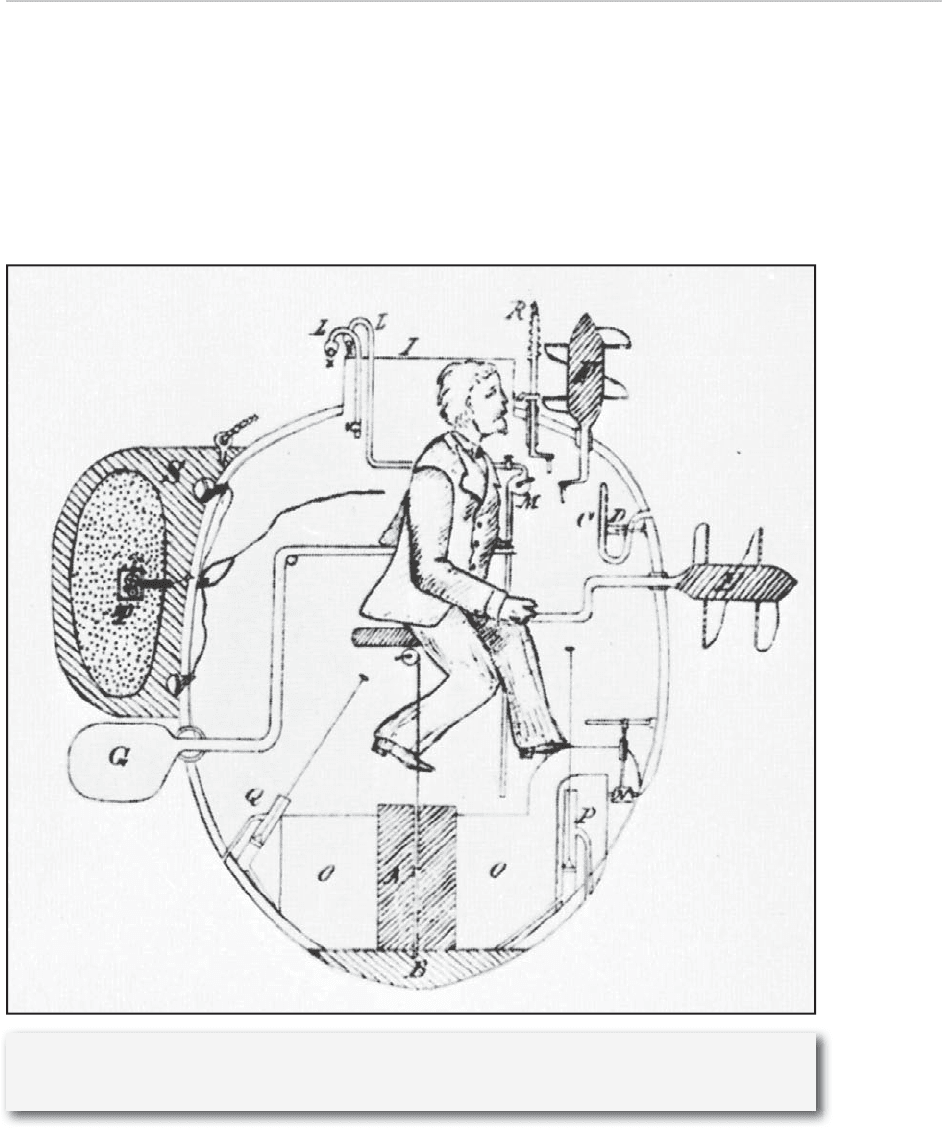
134 | The American Revolutionary War and the War of 1812: People, Politics, and Power
was armed with a mine, or a torpedo, to
be attached to the hull of an enemy ship.
Several attempts were made with Bush-
nell’s “Turtle” against British warships.
Though the submarine gave proof of
underwater capability, the attacks were
failures, partly because Bushnell’s phys-
ical frailty made it almost impossible for
which was fi rst tested during the Amer-
ican Revolution.
Graduated from Yale in 1775, at the
outbreak of the Revolution, Bushnell
went to Saybrook, where he built a unique
turtle-shaped vessel designed to be pro-
pelled under water by an operator who
turned its propeller by hand. The craft
Bushnell’s submarine torpedo boat, 1776. Drawing of a cutaway view made by Lt. Cmdr.
F.M. Barber in 1885 from a description left by Bushnell. Courtesy of the U.S. Navy
